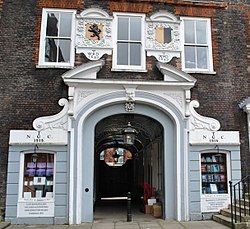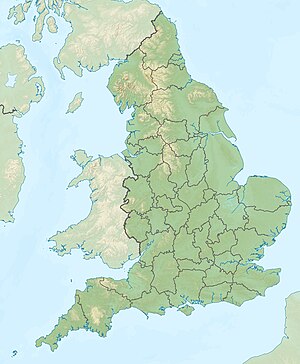John Pickering (soldier)
John Pickering | |
|---|---|
 Lincoln's Inn, where Pickering trained as a lawyer | |
| Commissary-General, Army of the Eastern Association | |
| In office August 1643 – February 1644 | |
| Personal details | |
| Born | baptised 3 December 1615 Titchmarsh, Northamptonshire, England |
| Died | 24 November 1645 (aged 29) Ottery St Mary, England |
| Cause of death | Typhus |
| Resting place | Lyme Regis castle |
| Alma mater | St Catharine's College, Cambridge Gray's Inn |
| Occupation | Lawyer, soldier, and religious radical |
| Military service | |
| Allegiance | Parliamentarian |
| Years of service | 1642 to 1645 |
| Rank | Colonel |
| Battles/wars |
|
Colonel John Pickering (baptised 3 December 1615, died 24 November 1645) was a member of the landed gentry from Northamptonshire who served with the Parliamentarian army in the First English Civil War. Like his elder brother Sir Gilbert Pickering, a close ally of Oliver Cromwell, he was a religious Independent, known for his devout faith and radical views. Appointed colonel of an infantry regiment in the New Model Army, he died of fever at Ottery St Mary on 24 November 1645.
Personal details
John Pickering, baptised 3 December 1615, was born in
Pickering's elder brother,
Career
Pickering attended
In August 1643, he was appointed head of the
In April 1645, Sir
While based at
Despite this inauspicious beginning, the unit was seen as particularly close to Cromwell, and was described as one of the 'chiefest praying and preaching regiments in the army'.
Legacy
"John Pickering's Regiment of Foote" forms part of the modern Sealed Knot society, an Historical reenactment group dedicated to the English Civil War.[16]
References
- ^ a b Moseley & Sgroi 2010.
- ^ Worden 2012, p. 199.
- ^ Vennings 2004.
- ^ a b c d e Roberts 2004.
- ^ Jones 2010, p. 93.
- ^ Firth & Raitt 1911, pp. 45–46.
- ^ Hamilton 1890, p. 155.
- ^ Gentles 1992, pp. 16–17.
- ^ Preheim, Rick (19 June 2004). "Atonement For 2 Centuries Of Persecution". Washington Post. Retrieved 6 October 2022.
- ^ Wanklyn 2014, pp. 117–118.
- ^ Turnbull, Mark (24 January 2020). "English Civil War slaughter at Abingdon recalled on anniversary". Oxford Mail. Retrieved 19 December 2022.
- ^ Chandler, Andrew. "Politics, Economics and Religion in the formation of the New Model Army 1644-1645". Chandler Consultants. Retrieved 19 December 2022.
- ^ Childs 2022, p. 207.
- ^ Childs 2022, p. 208.
- ^ Durston 2004.
- ^ "Colonel John Pickering, His Regiment of Foote". Colonel John Pickering. Retrieved 19 December 2022.
Sources
- Childs, Jesse (2022). The Siege of Loyalty House: A new history of the English Civil War. Bodley House. ISBN 978-1847923721.
- Durston, Christopher (2004). "Hewson, John, appointed Lord Hewson under the Protectorate(fl. 1630–1660)". doi:10.1093/ref:odnb/13157. (Subscription or UK public library membershiprequired.)
- Firth, Charles; Raitt, R.S (1911). Acts and Ordinances of the Interregnum, 1642-1660. HMSO. Retrieved 26 November 2022.
- Gentles, Ian (1992). The New Model Army in England, Ireland and Scotland, 1645-1653. Blackwell. ISBN 978-0631158691.
- Hamilton, W.D, ed. (1890). Calendar of State Papers Domestic: Charles I, 1644-1645, Volume 503, November to December 1644. HMSO.
- Jones, William R (2010). A History of St Catharine's College, Cambridge. CUP. ISBN 978-1108008969.
- Moseley, Virginia; Sgroi, Rosemary (2010). PICKERING, Sir John (1585-1628), of Titchmarsh, Northants in The History of Parliament: the House of Commons 1604–1629. CUP. ISBN 978-1107002258.
- Roberts, Keith (2004). "Pickering, John (bap. 1615, d. 1645)". doi:10.1093/ref:odnb/22210. (Subscription or UK public library membershiprequired.)
- Vennings, Keith (2004). "Pickering, Sir Gilbert, first baronet, appointed Lord Pickering under the Protectorate (1611-1668)". doi:10.1093/ref:odnb/22207. (Subscription or UK public library membershiprequired.)
- Wanklyn, Malcolm (2014). "Choosing Officers for the New Model Army, February to April 1645". Journal of the Society for Army Historical Research. 92 (370): 109–125. JSTOR 44232556.
- Worden, Blair (2012). God's Instruments: Political Conduct in the England of Oliver Cromwell. OUP. ISBN 978-0199570492.

